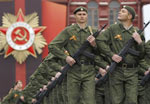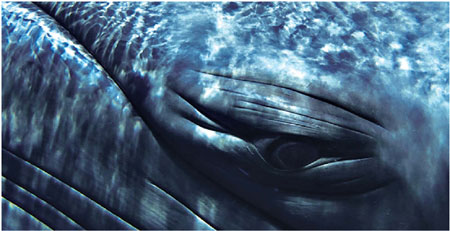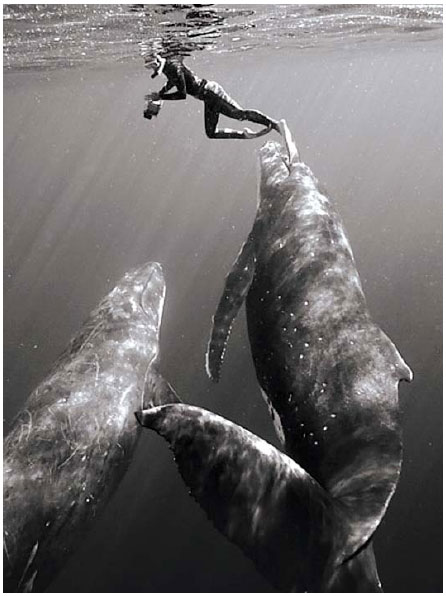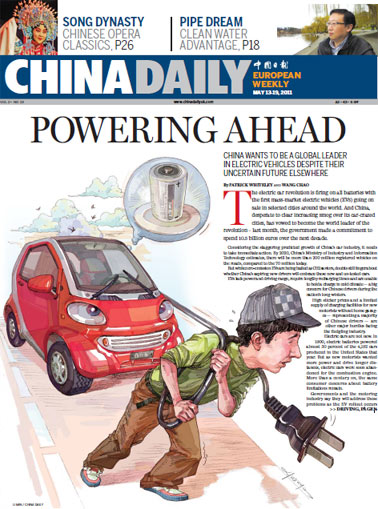Art
Whales' grandeur, seen very close
Updated: 2011-05-08 07:49
By Yudhijit Bhattacharjee (New York Times)
|
A dwarf Minke whale, photographed in 2009 at the Great Barrier Reef in Australia. Bryant Austin, a photographer, grew fascinated with the sheer scale of whales while snorkeling. Bryant Austin |
|
Bryant Austin has spent countless hours photographing whales. His fullsize portraits have been displayed in Europe, Japan and the United States. Bryantaustin |
Creating a bond through mammals' life-size images
On a warm summer afternoon in 2005, Bryant Austin was snorkeling in the blue waters of the South Pacific by the islands of Tonga, looking through his camera at a humpback whale and her calf swimming less than 45 meters away. As he waited for the right moment, the playful calf swam right up to him, so close that he had to lower his camera. That's when he felt a gentle tap on his shoulder.
Turning around, Mr. Austin found himself looking straight into the eye of the mother whale, her body bigger than a school bus. The tap had come from her pectoral fin, weighing more than 900 kilograms.
To Mr. Austin, her gesture was an unmistakable warning that he had gotten too close to the calf. And yet, the mother whale had extended her fin with such precision and grace - to touch the photographer without hurting him - that Mr. Austin was in awe of her "delicate restraint."
The moment changed Mr. Austin's life. It struck him that something was missing from four decades of whale photography: the beauty of true scale. Mr. Austin concluded that the only way to capture the magnificence of whales would be to create life-size pictures of them. "I wanted to recreate the feeling I had when I looked into vthe eye of the mother whale," he said.
Mr. Austin has since pursued that dream, spending countless hours in the company of whales. Working with five different whales from three species, he has created 25 true-scale pictures, including two full portraits - each composed from dozens of photographs of different sections of the whale's body.
The largest photo is a 2-by-9-meter portrait of a dwarf Minke whale from the Great Barrier Reef in Australia; the panels that make up the image weigh a total of 272 kilograms. Some of Mr. Austin's work went on display in April at the Electric Works gallery in San Francisco.
Mr. Austin, founder of a nonprofit organization called Marine Mammal Conservation Through the Arts, has exhibited his images in Norway, Iceland and Japan, all whaling nations. Although an international moratorium on commercial whaling has been in effect since 1986, these countries and a few others kill several hundred whales every year. Mr. Austin's hope is that his portraits of whales in their life-size splendor will give audiences an emotional connection to these animals, building support to end whaling.
He also wishes to raise awareness about the other threats that whales face today, from deaths caused by entanglement in fishing gear to the acidification of oceans caused by global warming.
"The images are unique and true representations of beings so vastly alien to us, yet connected through the mammalian way," said Elizabeth Eyre, a whale biologist at Macquarie University in Sydney. "The sheer size of the portraits alone allows viewers to grasp the discrepancy in dimension between us and them."
The images are also noteworthy for their remarkable detail. "Every parasite, scar, flake of peeling skin is visible," Ms. Eyre said.
Mr. Austin doesn't take his boat closer than 3 meters to a whale, preferring to let the animal swim up to him. He uses the same vessel every day, and approaches the whales' site at a slow and steady two knots.
At an exhibition in Tokyo last December, Mr. Austin's portraits evoked curiosity and praise, generating the emotional response that the photographer hopes to stir in his audiences, said Kotoe Sasamori, a Japanese naturalist and whale-watching guide who helped organize the event.
The New York Times
E-paper

War of the roses
European Chinese rose growers are beating their Chinese rivals at their own game
Preview of the coming issue
High-tech park gets big boost
At the source
Specials

New wave
Coastal city banks on marine sector to ride next stage of economic development

Drunk driving
Drunk drivers face a detention for one to six months and a revokation of their drivers' license.

V-Day parade
A military parade marking the 66th anniversary of the Soviet victory over Nazi.


